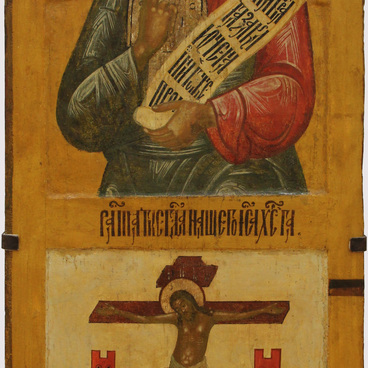Saint Cosmas and Damian
Creation period
17th century
Dimensions
90,1x71,1 cm
90.1x71.1x4.2 cm
90.1x71.1x4.2 cm
Technique
Wood,Tempera
Exhibition
0
Open in app#1

Unknown author
Saint Cosmas and Damian
#3
#2
Brothers Cosmas and Damian were Roman, or, according to other sources, Arabian or Asian healers in the 3rd century AD. They healed people, preached Christianity, led a pious life, but were killed by the pagans: they were beheaded by order of a Roman military leader. The images of these saints first appeared in the first millennium. In Thessaloniki, Greece, there is a mosaic in the temple of Saint George, which was discovered in the 5th century AD.
The icon ‘Saints Cosmas and Damian’ from the collection of the State Art Museum of Khanty-Mansiysk was created in the 17th century. Cosmas is depicted on the left, with a cross in his left hand, and Damian on the right, with a cross in his right hand. The icon was created by icon painters from Vologda.
The icon ‘Saints Cosmas and Damian’ from the collection of the State Art Museum of Khanty-Mansiysk was created in the 17th century. Cosmas is depicted on the left, with a cross in his left hand, and Damian on the right, with a cross in his right hand. The icon was created by icon painters from Vologda.
#4
The Vologda school of icon
#5
The Vologda school of icon painting developed in the 14th century. At the time, the Vologda icons were painted in a special sophisticated manner, and because of the local pigments, the paints lost their bright color with time and acquired a cool shade. By the time this icon was created, the Vologda icon painting had adopted some features of Moscow and Novgorod schools, with their expressive lines and vibrant colors.
Icon painters used tempera. This paint was made from powder pigments and raw egg yolk. To paint the faces of the saints, ocher was mixed based on rust and clay. This paint formed a dense and even layer. Changing the proportions in its composition, the artists obtained several shades, from sandy to red.
#6
A leaf-gold cover
#7
The icon was decorated with a leaf-gold cover. It covered the icon frame, but also the background of the icon in the ark, a special recess for the main image. At the time, not only gold, but also thin sheets of silver, brass or cupronickel were used to create icon covers. Using special relief blocks, drawings were manually embossed on them. They could include hagiographic motifs, background patterns or ornaments. This technique was called basma stamping, so the icon covers are often called basma stamped icon frames. The basma stamping technique was used to decorate icon frames, but also church books, and even entire iconostases of Russian churches.
#8
The icon was kept in various churches. In the late 1980s, the icon found its way into the collection of a Saint-Petersburg philanthropist Viktor Samsonov. In 1996, it was bought by the Generation Fund of the Khanty-Mansiysk Autonomous District for an art gallery. Fifteen years later, the icon ‘Saints Cosmas and Damian’ was transferred to the museum collection.
#9
State Museum of Fine Arts of Khanty-Mansiysk
read morehide
00:00
00:00
1x
Saint Cosmas and Damian
Creation period
17th century
Dimensions
90,1x71,1 cm
90.1x71.1x4.2 cm
90.1x71.1x4.2 cm
Technique
Wood,Tempera
Exhibition
0
Open in app
Share

